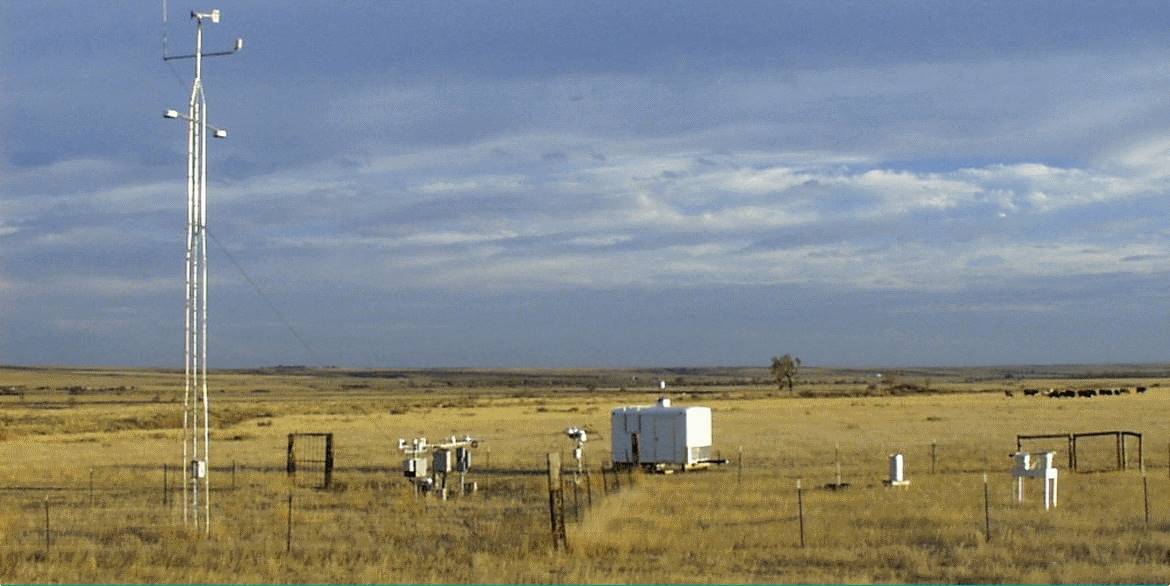How accurate are SolarAnywhere® irradiance data? They are accurate enough to identify an undetected calibration error at one of the nation’s most trusted ground truth stations.
Figure 1 presents Direct Normal Irradiance (DNI) and Global Horizontal Irradiance (GHI) measured at the Fort Peck, Montana SURFRAD station and satellite-based SolarAnywhere GHI on comparable clear days in 2013 and 2015 (July 31, 2013 and July 31, 2015). Measured DNI (left graph) is nearly identical for both years. SolarAnywhere GHI (right graph) is nearly identical for both years. Measured GHI (middle graph), however, is not. The measured 2015 GHI is substantially lower than the measured 2013 GHI.
There is no straightforward physical cause to explain why the 2015 GHI observation would be lower while DNI remains constant. We concluded that there was a GHI calibration error at the SURFRAD station. The SURFRAD site operator later substantiated this conclusion.
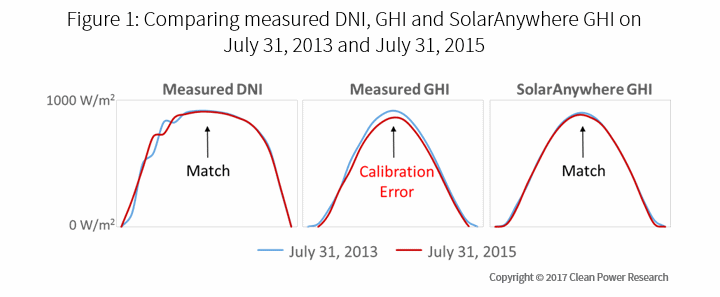
SolarAnywhere user triggered inquiry
A SolarAnywhere user triggered the inquiry into this matter. The user was comparing SolarAnywhere data against Fort Peck ground-truth station data. Fort Peck is part of 7-station SURFRAD network operated by NOAA in the U.S. It is part of the Baseline Surface Radiation Network (BSRN). Fort Peck is a trusted source of ground-truth irradiance data. Solar resource models such as SolarAnywhere use this data for benchmarking purposes.
The SolarAnywhere user noticed unexplained discrepancies between the two datasets. The user reported that the year-to-year variability was not always well-matched to Fort Peck ground observations. Figure 2 compares the annual, measured GHI to SolarAnywhere GHI. SolarAnywhere data are significantly higher than ground measurements in 2015.
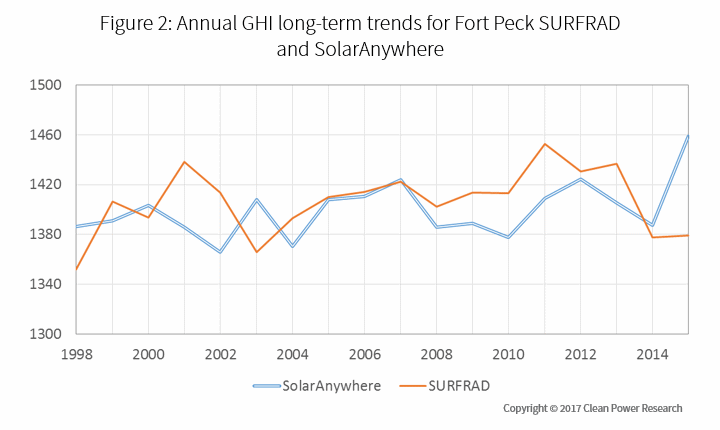
Further Investigation into the calibration error
The 2015 result slightly exceeded the published margin of error of the untuned model. Our first assumption was that this was an acceptable level of uncertainty. A strength of satellite data, however, is the ability to provide a long-term evaluation resource that accurately accounts for year-to-year variability. This is beneficial to developers and planners. We decided to investigate this issue further.
A closer look at the hourly data revealed the underlying nature of the observed trend difference. Figure 3 compares SolarAnywhere GHI against Fort Peck SURFRAD measurements in 2013 and 2015.
SolarAnywhere’s higher bias in 2015 is visible through clear sky condition events; i.e., the points densely concentrated near the 1-1 line during higher irradiance conditions. There is a close alignment between clear sky points detected by the ground and SolarAnywhere data in 2013. SolarAnywhere data are systematically higher than ground measurements in 2015.
There are no significant differences in the satellite model’s turbidity inputs (i.e., AOD and precipitable water) underlying clear sky calculations between the two years. The difference in Figure 3 must originate from ground observations.
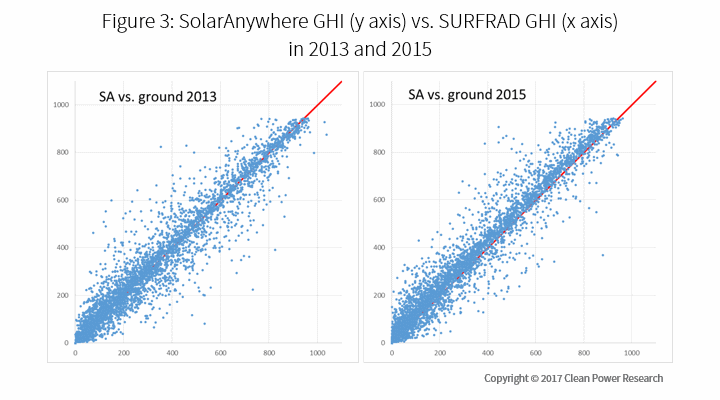
Figure 4 compares measured GHI clear sky events in 2013 and 2015. Each point of the scatter plot corresponds to conditions when SolarAnywhere GHI was above 92 percent of clear sky conditions (i.e., Kt*> 0.92) in both years for the same calendar day and same time. The sample of coincident points indicates a mean ~ 3.4% decrease of observed clear sky conditions GHI from 2013 to 2015.
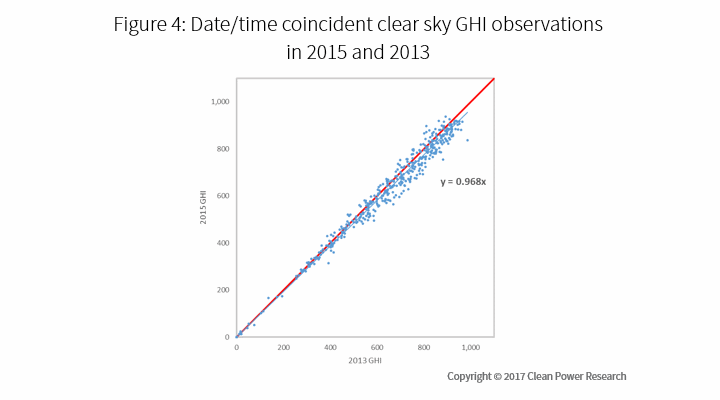
Source of error
What is the reason for this decrease in ground data in 2015? Was it due to higher turbidity in 2015 resulting from an intense fire season in the Western US? Or was it due to instrument calibration change? The former would show that the satellite model has limitations because it is not precise enough to adapt to changing turbidity conditions. The latter would suggest that SolarAnywhere can identify calibration issues.
We examined independently measured DNI at the Fort Peck station to answer this question. Examining DNI will amplify any GHI decrease if the cause is higher turbidity. We repeated the procedure of Figure 4 for DNI, selecting calendar/time of day-coincident points above a clear sky threshold in both years. Figure 5 presents the results.
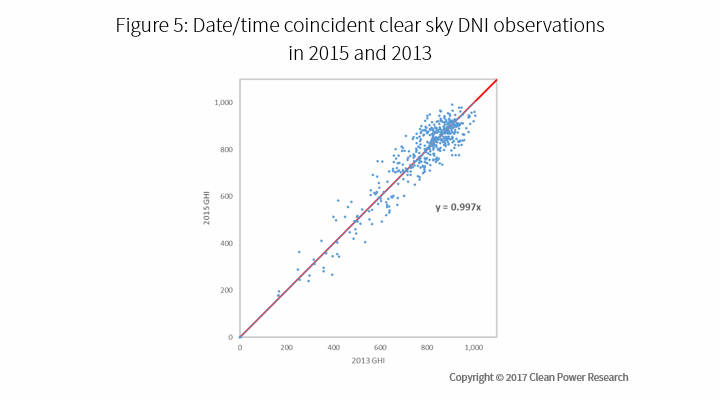
Results show that there is no appreciable change in clear sky DNI events in Fort Peck between 2013 and 2015. It is physically impossible to have a clear sky GHI reduction without a concurrent and larger clear sky DNI reduction. We can only conclude that the 2015 calibration of the SURFRAD GHI instrument was lower in 2015 than in 2013.
The example described in Figure 1 above both illustrates and ascertains this conclusion. Further, we used independently measured diffuse irradiance and DNI to calculate GHI. We found that indirectly measured GHI via diffuse and DNI was nearly identical in both years. This confirms the thesis of a GHI calibration error.
Confirmation by NOAA
We confirmed this result with an inquiry to NOAA. Personnel change SURFRAD instruments every year in September. There were indeed calibration mismatch issues with the GHI sensor that covered much of 2015. NOAA is correcting this issue. Fortunately, this will not affect BSRN climate model evaluation studies since they are based on the preferred method of indirectly measuring GHI from DNI and diffuse.
Bottom line
We draw three conclusions from this work. First, SolarAnywhere is a reliable source of relative long-term solar resource data. It is precise enough to identify calibration issues for one of the nation’s most trusted irradiance ground-truth datasets.
Second, satellite data tuning is only as good as the instruments used for tuning. A user must confirm proper calibration and maintenance before proceeding with data tuning.
Third, this exercise confirms that it is safer to use DNI and diffuse to calculate GHI for ground-truth applications if these two components are available, independently measured, and reliably calibrated and maintained. This agrees with World Meteorological Organization and others’ recommendations.
